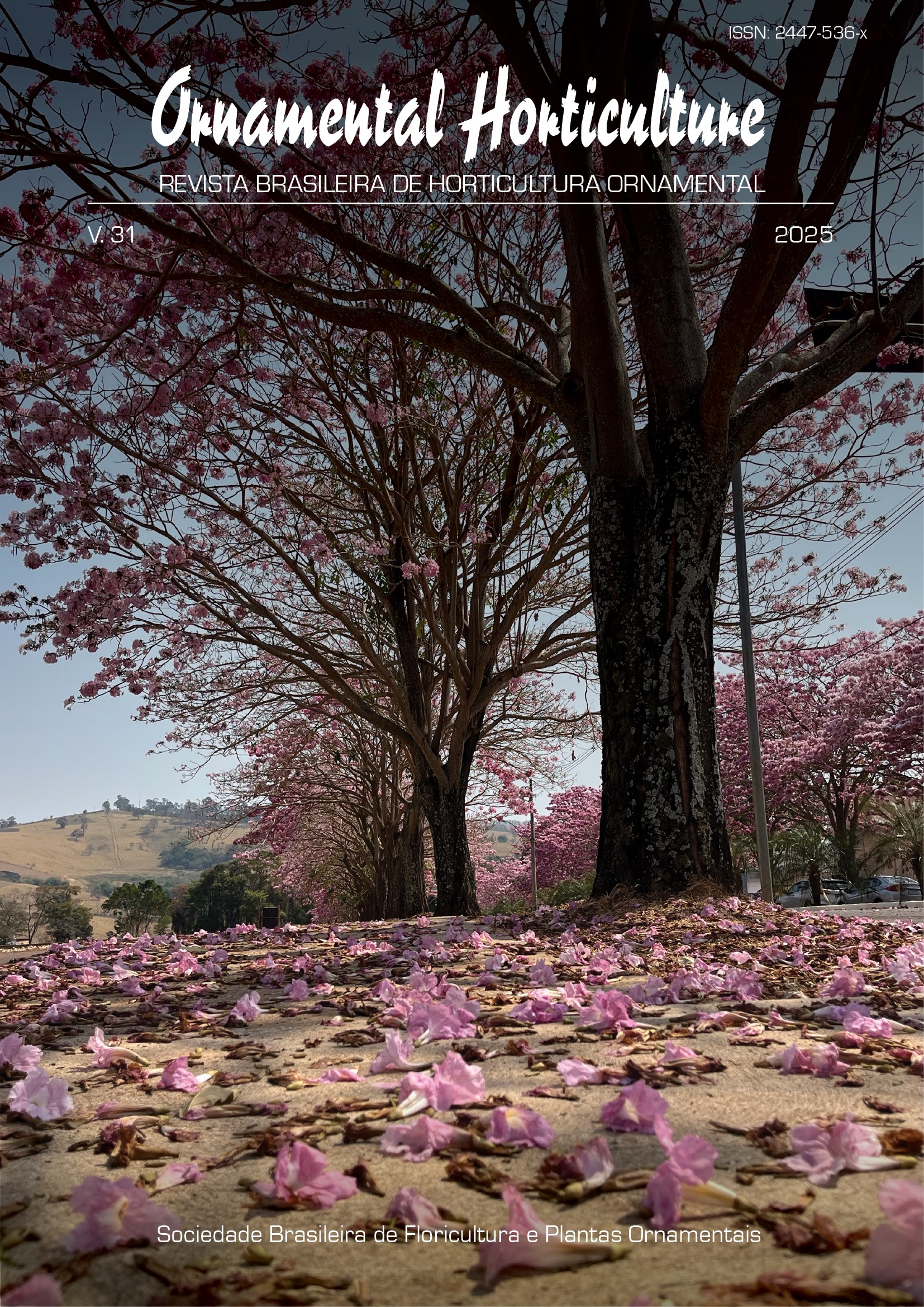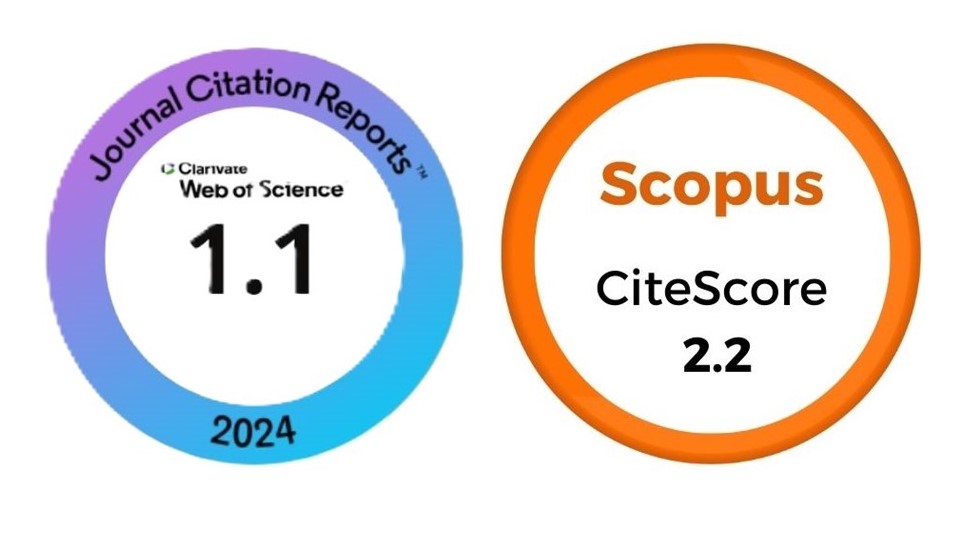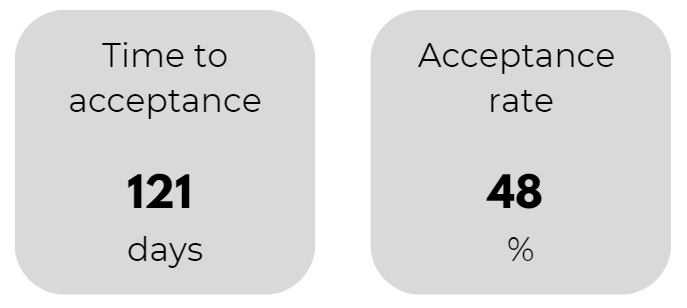Os tratamentos com água quente realizados na base do caule floral reduzem a senescência pós-colheita do lírio de corte
DOI:
https://doi.org/10.1590/2447-536X.v31.e312854Palavras-chave:
antocianina, choque térmico, Lilium longiflorum, tépalas, vida útil em vasoResumo
Os lírios são comumente cultivados para serem comercializados como flores de corte. A colheita causa um estresse considerável, que, por sua vez, desencadeia a senescência acelerada, sendo este processo um fator limitante da vida pós-colheita. O controle da senescência é alcançado por meio de várias metodologias, incluindo tratamentos térmicos em temperaturas moderadas por um curto período de tempo. Esses tratamentos geram um estresse leve que pode afetar o metabolismo dos tecidos. O objetivo deste estudo foi determinar a qualidade, a vida pós-colheita e o metabolismo de Lilium longiflorum após a aplicação de estresse térmico na base dos caules das flores. Os tratamentos foram realizados durante 5 minutos a 50 °C com água nos primeiros 2 cm da área de corte, enquanto um tratamento semelhante foi realizado com água a 20 °C para o controle. Os caules tratados apresentaram menor perda de peso, menor consumo de água e os botões abriram mais tarde. Da mesma forma, foi observada menor senescência e menor perda de clorofila nas folhas das amostras tratadas. Uma tendência a uma maior concentração de fenóis foi observada nos primeiros dias de armazenamento nas folhas e tépalas dos caules tratados, enquanto não foram detectadas variações significativas no teor de flavonoides. Menores quantidades de TBARS e menor perda de eletrólitos foram detectadas nas amostras tratadas com calor, indicando menor peroxidação e maior estabilidade da membrana. O tratamento também induziu maior acúmulo de antocianinas nas tépalas. Os resultados sugerem que o tratamento térmico com água quente no pós- colheita é um método adequado para melhorar a qualidade das hastes, o grau de abertura dos botões e atrasar a senescência, prolongando a vida em vaso sem efeitos negativos durante o armazenamento.
Downloads
Referências
AL FAYAD, A.; OTHMAN, Y. Pre-Harvest chemical compounds influence Lily (Lilium × elegans) leaf and flower indigenous phenols, flavonoids and gibberellic acid levels. International Journal of Plant Biology, v.15, p.551–560, 2024. https://doi.org/10.3390/ijpb15030042
AL-AJLOUNI, M.A.; OTHMAN, Y.A.; A’SAF, T.A.; AYAD, J.Y. Lilium morphology, physiology, anatomy and postharvest flower quality in response to plant growth regulators. South African Journal of Botany, v.156, p.43-53, 2023. https://doi.org/10.1016/j.sajb.2023.03.004
ALINIAEIFARD, S.; FALAHI, Z.; DIANATI DAYLAMI, S.; LI, T.; WOLTERING, E. Postharvest spectral light composition affects chilling injury in anthurium cut flowers. Frontiers in Plant Science, v.11, p.846, 2023. 10.3389/fpls.2020.00846
ALLEN, R.G.; SMITH, M.; PEREIRA, L.S.; RAES, D.; WRIGHT, J.L. Revised FAO Procedures for calculating evapotranspiration: irrigation and drainage paper No. 56 with testing in Idaho. Watershed Management and Operations Management, v.56, p.1-10, 2000. https://doi.org/10.1061/40499(2000)125
ARROM, L.; MUNNÉ-BOSCH, S. Hormonal changes during flower development in floral tissues of Lilium. Planta, v.236, p.343-354, 2012. https://doi: 10.1007/s00425-012-1615-0.
BARRIGA LOURENCO, A.; CASAJÚS, V.; RAMOS, R.; MASSOLO, F.; SALINAS, C.; CIVELLO, P.; MARTÍNEZ, G. Postharvest shelf life extension of minimally processed kale at ambient and refrigerated storage by use of modified atmosphere. Food Science and Technology International, v.30, p.713-721, 2023. https://doi.org/10.1177/10820132231195379
CHANTRACHIT, T.; PAULL, R.E. effect of hot water on red ginger (Alpinia purpurata) inflorescence vase life. Postharvest Biology and Technology, v.14, n.1, p.77-86, 1998. https://doi.org/10.1016/s0925-5214(98)00033-7
COSTA, L.C.; DE ARAUJO, F.F.; RIBEIRO, W.S.; DE SOUSA SANTOS, M.N.; FINGER, F.L. Postharvest physiology of cut flowers. Ornamental Horticulture, v.27, p.374-385, 2021. https://doi.org/10.1590/2447-536X.v27i3.2372
FERRANTE, A. Ethylene and horticultural crops. In: KHAN, N.; FERRANTE, A.; MUNNÉ-BOSCH, S. (eds). The Plant Hormone Ethylene. New York: Academic Press, 2023. p.107-121.
GIUSTI M.; WROLSTAD R. Characterization and measurement of anthocyanins by UV visible spectroscopy. Current Protocols in Food Analytical Chemistry, 00(1), F1.2.1–F1.2.13, 2001. http://dx.doi.org/10.1002/0471142913.faf0102s00
HAJAM, Y.A.; LONE, R.; KUMAR, R. Role of plant phenolics against reactive oxygen species (ROS) induced oxidative stress and iochemical alterations. In: Lone, R.; Khan, S.; Al-Sadi, M. (Eds). Plant Phenolics in Abiotic Stress Management. Berlin: Springer Nature, 2023. p.125-147.
KATO, M.; KAMO, T.; WANG, R.; NISHIKAWA, F.; HYODO, H.; IKOMA, Y., SUGIURA, M.; YANO, M. Wound-induced ethylene synthesis in stem tissue of harvested broccoli and its effect on senescence and ethylene synthesis in broccoli florets. Postharvest Biology and Technology, v.24, p.69-78, 2002. https://doi.org/10.1016/S0925-5214(01)00111-9
LU, N.; WU, L.; SHI, M. Selenium enhances the vase life of Lilium longiflorum cut flower by regulating postharvest physiological characteristics. Scientia Horticulturae, v.264, p.109172, 2020. https://doi.org/10.1016/j.scienta.2019.109172
MALAKAR, M.; DE OLIVERA PAIVA, P.D.; BERUTO, M.; DA CUNHA NETO, A.R. Review of recent advances in post-harvest techniques for tropical cut flowers and future prospects: Heliconia as a case-study. Frontiers in Plant Science, v.14, p.462, 2023. https://doi.org/10.3389/fpls.2023.1221346
MANTILLA, G.; LORENZO, G.; MASCARINI, L. Hormonal endogenous changes in response to the exogenous 6-benzylaminopurine application in pre-and post-harvesting lilium flower stalks. Ornamental Horticulture, v.27, n.3, p.357-364, 2021. https://doi.org/10.1590/2447-536X.v27i3.2337
MUHAMMAD, N.; LUO, Z.; YANG, M.; LI, X.; LIU, Z.; LIU, M. The joint role of the late anthocyanin biosynthetic UFGT-encoding genes in the flowers and fruits coloration of horticultural plants. Scientia Horticulturae, v.301, p.111110, 2022. https://doi.org/10.1016/j.scienta.2022.111110
PAGE, T.; GRIFFITHS, G.; BUCHANAN-WOLLASTON, V. Molecular and biochemical characterization of postharvest senescence in broccoli. Plant Physiology, v.125, p.718-727, 2001. https://doi.org/10.1104/pp.125.2.718
PATTYN, J.; VAUGHAN HIRSCH, J.; POEL, B.V.D. The regulation of ethylene biosynthesis: a complex multilevel control circuitry. New Phytologist, v.229, p.770-782, 2020. https://doi.org/10.1111/nph.16873
PERINI, M.A.; SIN, I.N.; REYES JARA, A.M.; GÓMEZ LOBATO, M.E.; CIVELLO, P.M.; MARTÍNEZ, G.A. Hot water treatments performed in the base of the broccoli stem reduce postharvest senescence of broccoli (Brassica oleracea L. var Italica) heads stored at 20 Co. LWT, v.77, p.314–322, 2017. https://doi.org/10.1016/j.lwt.2016.11.066
ROGERS, H.; MUNNÉ-BOSCH, S. Production and scavenging of reactive oxygen species and redox signaling during leaf and flower senescence: similar but different. Plant Physiology, v.171, p.1560-1568, 2016. https://doi.org/10.1104/pp.16.00163
SEATON, K.; JOYCE, D. Effects of low temperature and elevated CO2 treatments and of heat treatments for insect disinfestation on some native Australian cut flowers. Scientia Horticulturae, v.56, p.119-133, 1993. https://doi.org/10.1016/0304-4238(93)90013-G
SINGH, A.; KUMAR, J.; KUMAR, P. Effects of plant growth regulators and sucrose on post harvest physiology, membrane stability and vase life of cut spikes of gladiolus. Plant Growth Regulation, v.55, p.221-229, 2008. https://doi.org/10.1007/s10725-008-9278-3
ŠOLA, I.; DAVOSIR, D.; KOKIĆ, E.; ZEKIROVSKI, J. Effect of hot-and cold-water treatment on broccoli bioactive compounds, oxidative stress parameters and biological effects of their extracts. Plants, v.12, p.1135, 2023. https://doi.org/10.3390/plants12051135
SUN J.; GUO H.; TAO J. Effects of harvest stage, storage, and preservation technology on postharvest ornamental value of cut peony (Paeonia lactiflora) flowers. Agronomy, v.12, p.230, 2022. https://doi.org/10.3390/agronomy12020230
SUN, X.; QIN, M.; YU, Q.; HUANG, Z.; XIAO, Y.; LI, Y.; MA, N.; GAO,J. Molecular understanding of postharvest flower opening and senescence. Molecular Horticulture, v.1, p.7, 2021. https://doi.org/10.1186/s43897-021-00015-8
VAN DOORN, W.G.; HAN, S. Postharvest quality of cut lily flowers. Postharvest Biology and Technology, v.62, p.16, 2011. https://doi.org/10.1016/j.postharvbio.2011.04.013
WANG, Y.; ZHAO, H.; LIU, C.; CUI, G.; QU, L.; BAO, M.; WANG, J.; CHAN, Z.; WANG, Y. Integrating physiological and metabolites analysis to identify ethylene involvement in petal senescence in Tulipa gesneriana. Plant Physiology and Biochemistry, v.149, p.121-31, 2020. http://dx.doi.org/10.1016/j.plaphy.2020.02.001
WU, X.; ZHANG, H.; LIU, X.; LIU, Z.; WANG, C.; LIAO, W. Molecular hydrogen prolongs Lanzhou lily (Lilium davidii var. Unicolor) postharvest shelf-life via improving antioxidant capacity. Scientia Horticulturae, v.336, p.113431, 2024. https://doi.org/10.1016/j.scienta.2024.113431
ZAGOSKINA, N.V.; ZUBOVA, M.Y.; NECHAEVA, T.L.; KAZANTSEVA, V.V.; GONCHARUK, E.A.; KATANSKAYA, V.M.; BARANOVA, E.N.; AKSENOVA, M.A. Polyphenols in plants: structure, biosynthesis, abiotic stress regulation, and practical applications (Review). International Journal of Molecular Science, v.24, p.13874, 2023. https://doi.org/10.3390/ijms241813874
ZHANG, L.; YAN, L.; ZHANG, C.; KONG, X.; ZHENG, X.; DONG, L. Glucose supply induces psmyb2-mediated anthocyanin accumulation in Paeonia suffruticosa ‘Tai Yang’ cut flower. Frontiers in Plant Science, v.13, p.874526, 2022. https://doi.org/10.3389/fpls.2022.874526
ZHANG, Y.; GUO, P. XIA, X.; GUO, H.; LI, Z. Multiple layers of regulation on leaf senescence: new advances and perspectives. Frontiers in Plant Science, v.12, p.788996, 2021. https://doi.org/10.3389/fpls.2021.788996
ZHAO W.; ZHAO H.; WANG H.; HE Y. Research progress on the relationship between leaf senescence and quality, yield and stress resistance in horticultural plants. Frontiers in Plant Science, v.13, p.1044500, 2022. https://doi.org/10.3389/fpls.2022.1044500
Downloads
Publicado
Edição
Seção
Licença
Copyright (c) 2025 Ornamental Horticulture

Este trabalho está licenciado sob uma licença Creative Commons Attribution 4.0 International License.








